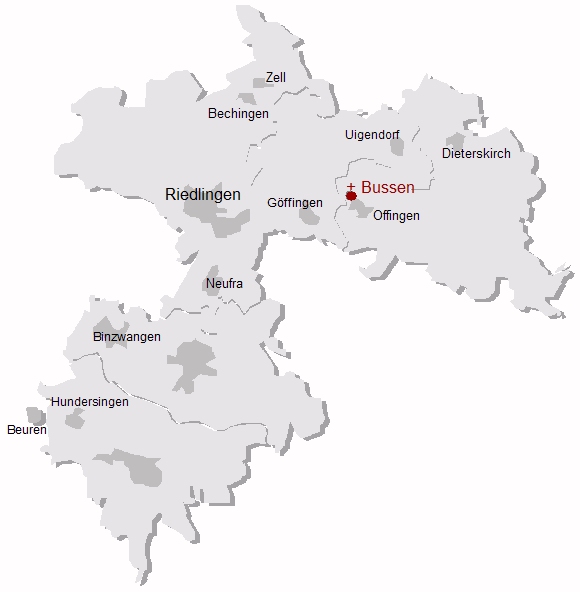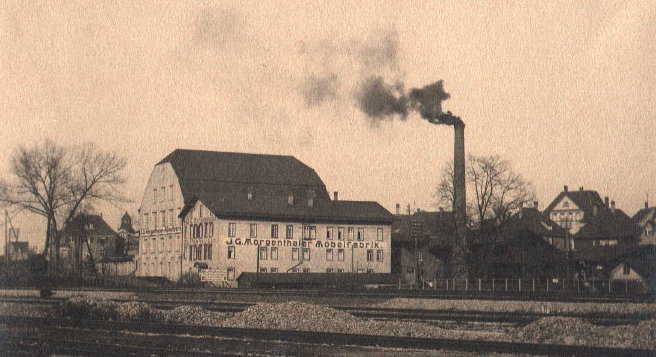|

The further towns in this region associated with the genealogical research Baur and Sigg as e.g. Binzwangen, Hundersingen, Beuren, Göffingen, Uigendorf, Offingen, Dieterskirch etc. are located within the visibility of the pilgrimage's montain Bussen.
Following Informations are taken from different sources (see below 1-6*). In extracts can be taken out:
Riedlingen the small town on the Danube, is situated between the foothills of the Schwäbischen Alb (Swabian Alb), the basin of the Danube, and the mountain Bussen from the geological point of view. Till now it has conserved it's Middle Ages townscape.
Riedlingen was founded by the Counts of Veringen about the year 1250. Already in the year around 1300 it was sold to the house of Habsburg and belonged until the peace of Pressburg in 1805 as one of the five Danubian towns to "Vorderösterreich" (hist. front or north west part of Austria). Riedlingen and its environs belong to the district Biberach since 1973 [1*].
Zell was already documented in the 6th and 9th century, Bechingen the first time in 1227. Both places are situated between the Bussen montain and the "Teutschbuch" at the border of the Danubian valley. Ecclesiastically Zell and Bechingen belong together [1*].
Neufra's earliest documentation as "Niufron" occured in 1171. Very early the nobles of Gundelfingen had here properties. After the local nobles became extinct in 1298 the noble line of Hornstein appeared as feudal lords who sold the place to the lords of Gundelfingen in 1399. The Helfensteins entered into the heritage of Neufra in 1546, their successor became the house of Fürstenberg by marriage in 1627. In 1806 finaly Neufra became a württembergian place. The view of Neufra is strongly influenced by the arrangement of the castle, the church "St. Peter und Paul" built in gotic, and the “Hängenden Gärten“ (hanging gardens), a momentous art-historical testimony of garden architecture of the 16th century [1*].
Erisdorf is situated in direct vicinity of Neufra, an is as Binzwangen on the Danube a part of Ertingen [2*].
Hundersingen is located few kilometres from Binzwangen upwards the Danube, which belongs as Marbach and Mieterkingen to the commune Herbertingen. All are part of the commune Herbertingen since 1974 due to the reform of the administrative districts in Baden-Württemberg [3*]. In Hundersingen parts of a settlement could be reconstructed from the Iron Age on the "Heuneburg", a Celtic prince residence[4*]. Archaeologic discoveries give a reference for expanded trade relations of the Celts up to the Mediterranean region. In extracts it is said: In a territory from the upper Danube to eastern France and to North West Switzerland some larger and outstanding altitude fortifications are set off apart from the structure of rustic settlements. For those centres of settlements in many cases in connection with luxury equipped tombs in monumental grave mounds the name "Fürstensitz" (residence of a prince) became generally applied, though it wasn't a noble community in the present sense naturally. "Fürstensitze" (residences of a prince) are heavy fortifications, their defense walls are made of solid timbered wooden construction charged with earth. The exceptional importance of that height settlement is demonstrated on the basis of the troves: In some of the outstanding pieces wide-ranging contacts are documented, mentioned should be painted greece Ceramic (pottery) which may came from the Mediterranean region to the North as representative commercial goods, diplomatic gifts or marriage portion. Examples for further "Fürstensitze" (residences of a prince) are "Le Mont Lassois" in the eastern part of France, the height settlement close to Châtillon-sur-Glâne in Switzerland and the "Hohenasperg" in northern Württemberg. Exceptionally good results were achieved at the archeological excavations on the Celtic "Heuneburg" on the upper Danube clo se to Hundersingen on the Danube.
"Heiliger Berg Oberschwabens" - Holy Montain Bussen - this a folkloristic name expresses best the respect the inhabitants of Upper Swabia [5*] show to the Bussen.
The first mention dates back 1200 years. Visible from far away and simultaneously vaunted for his wide view, place of a well-established and also today alive place of pilgrimage to Virgin Mary, for the inhabitants of the surrounding the Bussen is more than just a landmark he is a symbol of identification for the Upper Swabian homeland and memorial for the history of the region lasted for centuries. The church of pilgrimage located at the south-western peak appears most incisive by its far away shining. The remainder of a former castle is situated in the north-west round end of the Bussen, and beneath of the mountain side are some fragments of a former wall construction. At the latest from the 13th century there was a castle. The Habsburgs acquired the castle as property in 1281. From here noble reeves administrated the estate. In the 14th century the sewers of Waldburg got the Bussen as deposit, the mountain belonged to their sovereignty "Herrschaft Bussen", which remained, however, fiefdom of Austria [6*].
| 

